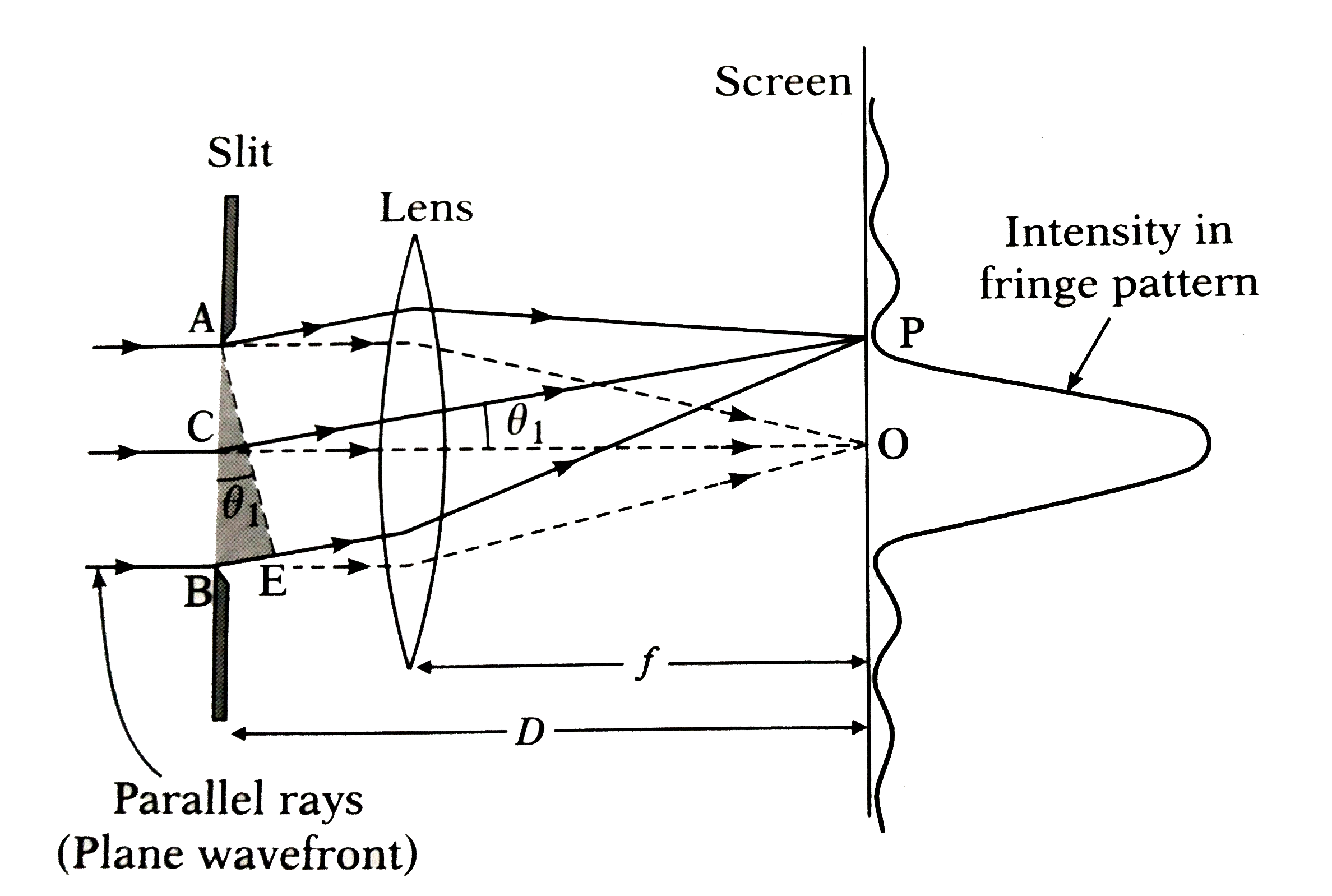The angular width of the central maximum of the diffraction patternn in a single slit (of width a) experiment, with λ as the wavelenth of light, is
When a parallel beam of monochromatic light (wavelength λ) illuminates a single slit of finite width a(a>>λ), we observe on a screen some distance from the slit a broad pattern of alternate dark and bright fringes. The pattern consists consists of a central bright fringe, with successive dark and bright fringes of diminishing intensity on both sides. This is called the diffraction pattern of a single slit.

Consider a single slit illuminated with a parallel beam of monochromtic light perpendicular to the plane of the slit. The diffraction pattern is obtained on a screen at a distance D(gtgta) from the slit and at the focal plane of the convex lens.
We can imagine the single slit as made up of a large number of Hugens sources evenly distributed over teh width of the slit. Then, the maxima and minima of the pattern arise from the interference of the various Huygens wavelets.
Now, imagine the single slit as being made up of two adjacent slits, each of width a/2. Since the incident plane wavefronts are parallel to the plane of the slit, all the Huygens sources at the slit will be in phase. They will therefore also be in phase at the point O on the screen, where O is equidistant from all the Hugens sources. At O, then, we get the central maximum.
For the first minimum of intensity on the screen, the path difference between the waves from the Huygens sources A and C (or C and B) is λ/2, which is the condition for destructive interference. Suppose the nodal line CP for the first minimum subtends an angle θ1 at the slit, θ1 is very small.
With P as the centre and PA as radius, strike an arc intersecting PB at E. Since D gtgt a, the arc AE can be considered a straight line at right angles to PB. Then △ABE is a right-angled triangle similar to △COP.
This means that ∠BAE=θ1.
∴BE=asinθ1.
But BE is the difference in path length, PB - PA.
∴BE=PB−PA=(PB−PC)+(PC−PA)
=λ2+λ2=λ
∴asinθ1=λ
∴sinθ1≅θ1=λa (∵θ1 is very small and in radian) ...(1)
The other nodal lines of intensity minima can be understood in a similar way. In general, then, for the mth minimum (m=±1,±2,±3,...),
θm=mλa (mth minimum) ...(2)
Between the above successive minima, the intensity rises to secondary maxima when the path difference is odd integral multiple of λ2:
asinθm=(2m+1)λ2=(m+12)λ
i.e., at angles given by
θm≅sinθm=(m+12)λa (mth secondary maximum) ...(3)
Topper's Solved these Questions
- DERIVATIONS-IIBook:NAVNEET PUBLICATION - MAHARASHTRA BOARDChapter:DERIVATIONS-IIExercise:Electrostatics
Explore 12 Videos
- DERIVATIONS-IIBook:NAVNEET PUBLICATION - MAHARASHTRA BOARDChapter:DERIVATIONS-IIExercise:Current Electricity
Explore 6 Videos
- DERIVATIONS-IIBook:NAVNEET PUBLICATION - MAHARASHTRA BOARDChapter:DERIVATIONS-IIExercise:Assignments
Explore 9 Videos
- DERIVATIONS-IBook:NAVNEET PUBLICATION - MAHARASHTRA BOARDChapter:DERIVATIONS-IExercise:Assignments
Explore 9 Videos
- DISTINGUISH BETWEENBook:NAVNEET PUBLICATION - MAHARASHTRA BOARDChapter:DISTINGUISH BETWEENExercise:Assingment
Explore 3 Videos
Similar Questions
Knowledge Check
Angular width (β) of central maximum of a diffraction pattern on a single slit does not depend upon
A(a) Distance between slit and sourceB(b) Wavelength of the slitC(c) Width of the slitD(d) Frequency of light usedAngular width of central maxima of a single slit diffraction pattern is independent of
Aslit widthBfrequency of the light usedCwavelength of the light usedDdistance between slit and screenThe angular size of the central maxima due to a single slit diffraction is (a → slit width)
AλaB2λaC3λ2aDλ2a
A narrow slit is illuminated by a parallel beam of monochromatic light of wavelength λ equals to 6000 Å and the angular width of the central maxima in the resulting diffraction pattern is measured. When the slit is next illuminated by light of wavelength λ, the angular width decreases by 30%. calculate the value of the wavelength λ.
View SolutionFind the half angular width of the central bright maximum in the fraunhofer diffraction pattern of a slit of width 12×10−5cm when the slit is illuminated by monochromatic light of wavelength 6000 Å.
View SolutionDetermine the angular spread between central maximum and first order maximum of the diffraction pattern due to a single slit of width 0.25mm, when light of wavelength 5890Å is incident on it normally ?
View SolutionAngular width of central maximum in the Fraunhofer diffraction pattern of a slit is measured. The slit is illuminated by another wavelengths, the angular width decreases by 30%. Calculate the wavelength of this light. The same decreases in angular width of central maximum is obtained when the original appertus is immersed in a liquid. find the refractive index of the liquid.
View SolutionFind the half angular width of the central bright maximum in the fraunhofer diffraction pattern of a slit of width 12×10−5cm when the slit is illuminated by monochromatic light of wavelength 6000 Å.
View Solution

